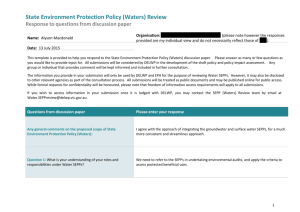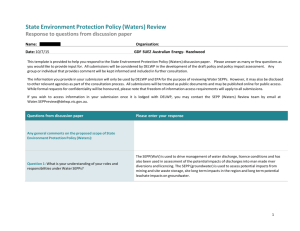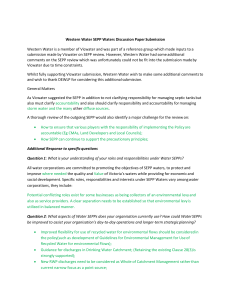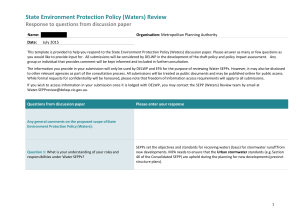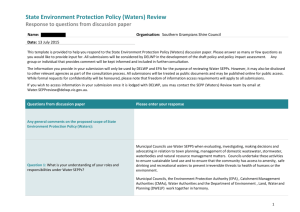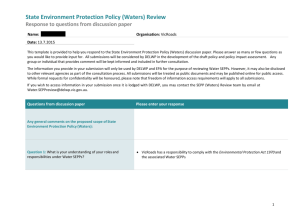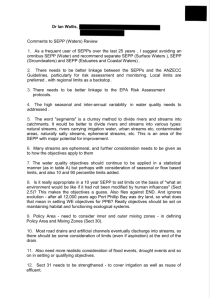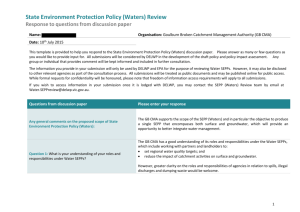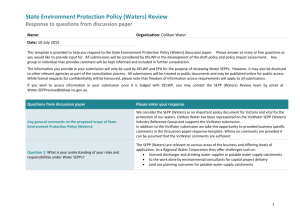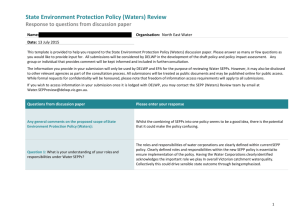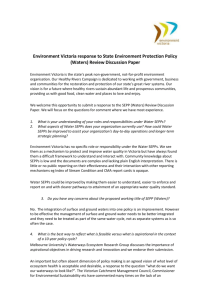Hume City Council - Department of Environment, Land, Water and
advertisement
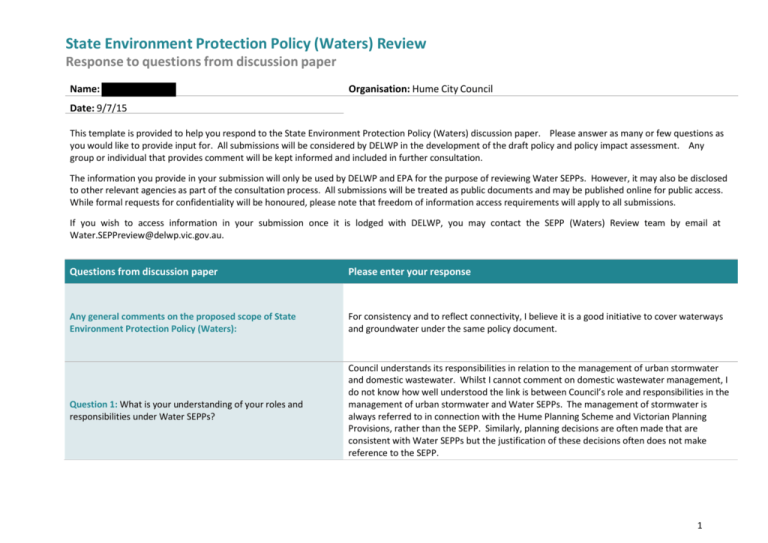
State Environment Protection Policy (Waters) Review Response to questions from discussion paper Name: Organisation: Hume City Council Date: 9/7/15 This template is provided to help you respond to the State Environment Protection Policy (Waters) discussion paper. Please answer as many or few questions as you would like to provide input for. All submissions will be considered by DELWP in the development of the draft policy and policy impact assessment. Any group or individual that provides comment will be kept informed and included in further consultation. The information you provide in your submission will only be used by DELWP and EPA for the purpose of reviewing Water SEPPs. However, it may also be disclosed to other relevant agencies as part of the consultation process. All submissions will be treated as public documents and may be published online for public access. While formal requests for confidentiality will be honoured, please note that freedom of information access requirements will apply to all submissions. If you wish to access information in your submission once it is lodged with DELWP, you may contact the SEPP (Waters) Review team by email at Water.SEPPreview@delwp.vic.gov.au. Questions from discussion paper Please enter your response Any general comments on the proposed scope of State Environment Protection Policy (Waters): For consistency and to reflect connectivity, I believe it is a good initiative to cover waterways and groundwater under the same policy document. Question 1: What is your understanding of your roles and responsibilities under Water SEPPs? Council understands its responsibilities in relation to the management of urban stormwater and domestic wastewater. Whilst I cannot comment on domestic wastewater management, I do not know how well understood the link is between Council’s role and responsibilities in the management of urban stormwater and Water SEPPs. The management of stormwater is always referred to in connection with the Hume Planning Scheme and Victorian Planning Provisions, rather than the SEPP. Similarly, planning decisions are often made that are consistent with Water SEPPs but the justification of these decisions often does not make reference to the SEPP. 1 State Environment Protection Policy (Waters) Review Response to questions from discussion paper Domestic wastewater, urban stormwater, water conservation (this is now referred to as water efficiency to recognise that an absolute minimisation of water use is not necessarily desirable), vegetation protection and rehabilitation. As stated above, although Council’s work in these areas is consistent with the water SEPPs, the SEPP is usually not referred to. Question 2: What aspects of Water SEPPs does your organisation currently use? How could Water SEPPs be improved to assist your organisation’s day-to-day operations and longer-term strategic planning? Water SEPPs could be improved in relation to urban stormwater management to provide consistent standards across land uses (residential, commercial and industrial), including infill developments to better protect waterways in undeveloped (but developing) areas. Better articulating the links between the Water SEPPs and Council’s water management responsibilities to ensure a broad understanding of the background to policy direction may help in some decision making processes. Question 3: Do you have any concerns about the proposed working title of State Environment Protection Policy (Waters)? If so, what are they? Question 4: What is the best way to reflect what is feasible versus what is aspirational in the context of a 10-year policy cycle? Question 5: Do you support the proposed SEPP (Waters) objective of “this policy is to protect and improve the quality of Victoria’s waters while providing for economic and social development”? Why? Short and long term goals could be articulated as such and named differently to reflect the timescale e.g. a SEPP for a particular environment may aim for a “target” (to be achieved in 5 years) and a “goal” (to be aimed at over 10 years). It may be possible to identify new beneficial uses that would arise if the long term goal(s) were to be achieved. Yes. Economic and social development can help to drive environmental improvements by creating income if well managed and appropriate to the location. 2 State Environment Protection Policy (Waters) Review Response to questions from discussion paper Question 6: Do you support the need to balance economic and social development with overall protection and improvement of water quality for Victoria’s water environments? Why? Question 7: What are the challenges of balancing economic and social development with protecting and improving water quality? How should we manage the appropriate trade-offs between them? Question 8: Do you foresee any problems or opportunities that may arise from creating one consistent SEPP to apply to all Victorian waters? Are there other options for streamlining the policies that we should consider? Yes but it is only likely to work if environmental and social values are given equal weighting to economic values. It is problematic because of the variables (including the nature of the economic activity and the location in which it is being carried out, how it will be managed). A risk based approach may be useful, based on the risk to the environmental values of the waters that the SEPP trying to protect. Additionally, trying to assign a dollar figure to environmental and social values is problematic and very subjective. There may be a danger that unique environments are not as well considered e.g. un-regulated waterways and ephemeral waterways. There needs to be a balance between consistent policy setting across the state and environments and managing the specifics of individual environments, particularly very high value and rare environments. Question 9: Are there any specific types of water environments, for example, a wastewater treatment lagoon, where you think beneficial uses should not be protected? Question 10: Do you think the current measures for classifying surface water and groundwater segments are still appropriate? Are there other measures that should be explored? 3 State Environment Protection Policy (Waters) Review Response to questions from discussion paper Question 11: Are there any problems with the spatial arrangements or segment boundaries in the existing Water SEPPs? If so, what are they? My concern is for the growth areas which will be on the transition between urban waters and cleared hills and coastal plains. Under which segment will they fall? They should be managed as cleared hills and coastal plains in order to maintain the higher environmental values that these segments will have. Question 12: What do you think are the advantages or problems with the new approach to segments and sub-segments? Targeted management of specific regions. Increased administration / potential for confusion Question 13: Are there any features of the landscape that you would like to see as a standalone segment or sub-segment? It may be worthwhile considering urban growth areas as a sub-segment to ensure that their higher values (as compared to urban waters) are recognised. Question 14: Do you believe that all beneficial uses set out in Table 2 of the discussion paper should still be protected under the new SEPP (Waters)? Where do you think a beneficial use would not apply? Why? Question 15: What method or approach could be used to apply the beneficial uses to segments and sub-segments? It could depend on the priorities for each segment / sub-segment e.g. is it a near pristine reach in an un-regulated waterway? If so, protection of the aquatic environment would be a very high priority. In a highly modified or urbanised environment, aesthetics or having good enough water quality for secondary contact activities may be sufficient. What is most appropriate for each segment / sub-segment? Do people in different geographical areas of Victoria rank the importance of different beneficial uses differently? 4 State Environment Protection Policy (Waters) Review Response to questions from discussion paper Question 16: Are there any additional beneficial uses that you believe should be protected? Are there any that you think should no longer be protected? Why? Question 17: What do you think about the current indicators, the approach for deriving objectives and the proposed changes? Good but hydrological indicators could also be used to assess flow regimes which may be good for urban environments or the urban – rural fringe where development is occurring. Question 18: How have nutrient load targets been useful in driving environmental investment outcomes? Would you like to see a different approach, and if so, what might that be? Question 19: What is the preferred method for management of at-risk areas? Are there activities that need greater intervention or regulation? What would the intervention be, for example, voluntary or mandatory codes of practice, regulation via licensing? Gas exploration or protection of waters for existing agriculture. Intervention could be mandatory, voluntary or incentivised based on risk. Question 20: What do you think the role of SEPP (Waters) should be in identifying and filling knowledge gaps over the life of the policy? How can we assure an adaptive approach within SEPP (Waters)? The SEPP can make reference to existing policy documentation and enabling mechanisms and also make reference to any future updates that may occur during the lifetime of the SEPP so that the latest science is always referenced if possible. 5 State Environment Protection Policy (Waters) Review Response to questions from discussion paper Any other information you would like to share: 6
